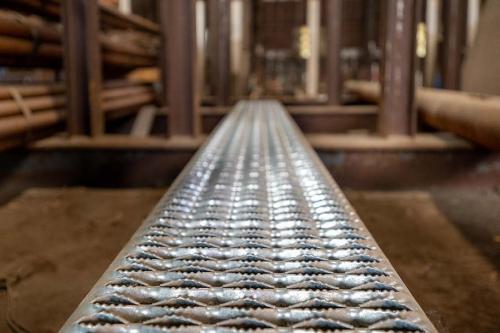Iron and steel are two of the most common materials used in industries like construction and manufacturing. Even though these two materials look similar, each have characteristics and qualities that make them unique. The primary difference is the fact that iron is an element as steel is an alloy made up of mostly iron and carbon.
Difference Between Iron and Steel
Another difference between iron and steel is the percentage of carbon contained in each material. Iron that contains more than two percent of carbon is known as pig iron whereas iron that contains less than two percent of carbon is referred to as steel. You can process the pig iron through various furnaces and processes in order to produce steel.
Further, you can add various other metals to steel in order to produce steel alloys. Steel alloys offer a variety of properties suited for a wide range of products and industries. For example, when chromium is added to steel, it results in a material called stainless steel. Stainless steel offers high resistance to corrosion and maintains a high strength-to-weight ratio. Steel is used on a large scale in industries like manufacturing and construction because steel is stronger than iron and it also has better tension and compression properties.
Iron Vs Steel
Iron and steel are two of the most commonly used metals in construction, manufacturing, and everyday products. While they may appear similar at first glance, they differ significantly in composition, properties, and applications. Understanding these differences is crucial for selecting the right material for any given purpose.
What Is Iron?
Iron is a chemical element with the symbol Fe (from the Latin ferrum) and atomic number 26. It is one of the most abundant elements on Earth and has been used by humans for thousands of years. In its pure form, iron is relatively soft and malleable. However, pure iron is rarely used in practical applications due to its lack of strength.
Iron comes in different forms:
-
Wrought Iron: Nearly pure iron with a small amount of slag, known for its ductility and resistance to corrosion.
-
Cast Iron: Contains 2-4% carbon and is known for its hardness and brittleness. It's commonly used in cookware and heavy machinery.
What Is Steel?
Steel is an alloy made primarily of iron and carbon, typically containing between 0.1% and 2% carbon by weight. The addition of carbon significantly improves iron's strength and hardness while maintaining some flexibility. Other elements like chromium, nickel, and manganese may be added to create specific types of steel with desirable properties such as corrosion resistance or greater tensile strength.
Common types of steel include:
-
Carbon Steel: The most basic form of steel, used in construction and tools.
-
Stainless Steel: Contains chromium, which makes it resistant to rust and staining.
-
Alloy Steel: Includes additional elements like tungsten or vanadium to enhance certain characteristics.
Key Differences Between Iron and Steel
| Feature | Iron | Steel |
|---|---|---|
| Composition | Pure or nearly pure element | Alloy of iron with carbon and other elements |
| Strength | Softer and weaker | Stronger and more durable |
| Flexibility | More malleable | More rigid but with controlled flexibility |
| Corrosion Resistance | Prone to rust (except wrought iron) | Can be rust-resistant (e.g., stainless steel) |
| Applications | Decorative items, antique tools | Buildings, bridges, tools, vehicles, appliances |
| Cost | Generally cheaper | Often more expensive due to processing and alloying |
Applications
-
Iron is commonly used in historical or decorative applications, such as fences, gates, and vintage cookware.
-
Steel is the backbone of modern infrastructure, used in everything from skyscrapers and ships to surgical instruments and kitchen appliances.
Conclusion
While iron is a naturally occurring element, steel is a man-made material that improves upon iron's properties through alloying. The differences in strength, durability, and versatility make steel more suitable for most industrial and structural uses, while iron retains value for its aesthetic qualities and specific niche uses. Knowing when to use iron versus steel depends on the requirements of the project—whether it's strength, flexibility, corrosion resistance, or cost.

